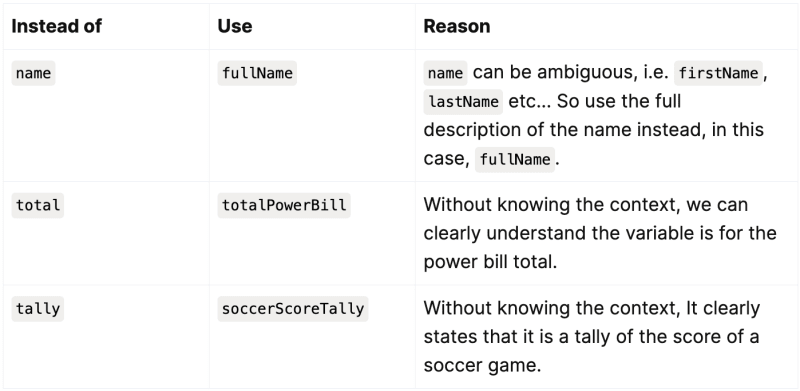In the world of programming and software development, variables serve as the building blocks for creating functional applications. They allow us to store and manipulate data, making our programs dynamic and interactive. However, the art of naming variables is often overlooked or underestimated, leading to code that is difficult to understand. By choosing unambiguous variable names, developers can greatly enhance the readability and maintainability of their code.
In this article, we will explore the importance of naming variables and provide some best practices to promote clarity. And although this article is more targeted towards junior and intermediate developers, it also serves as a reminder to more experienced devs on the importance of proper variable names.
1) Use descriptive names: One of the fundamental principles in variable naming is to choose names that accurately reflect the purpose or content of the variable. Instead of using generic names, opt for more descriptive and meaningful names that convey the intent of the variable. For example:
2) Avoid Abbreviations and Acronyms: While abbreviations and acronyms might seem like a convenient way to shorten variable names, they can often introduce ambiguity and confusion. Not everyone will be familiar with the same abbreviations, and different team members may interpret them differently. Instead, favour descriptive names that provide clarity and reduce the chances of misinterpretation. This is especially true for any developers coming into a new industry without prior domain knowledge. For example:
There are instances where common abbreviations can be used, these are usually very commonly used among developers, such as:
3) Naming variables to indicate the data type: When naming variables, it is important the name indicates the data type. This is so that when another developer reads a variable, they instantly know what data type it is and what it's used for. For example, boolean variables should start with is, has or can. And similarly, singular and plural also need to be considered when choosing variable names. This indicates whether the variable represents a single element such as a string, or number or multiple elements such as an array. Examples:
4) Be Mindful of Scope: The scope of a variable determines its visibility and lifespan within a program. When naming variables, it is essential to choose names that accurately reflect their scope. Variables with global scope, accessible throughout the program, should have names that indicate their broader purpose or functionality. On the other hand, variables with limited scope, such as local variables within a function or loop, can have more concise and specific names that reflect their immediate purpose. For example:
5) Be Consistent: Lastly, consistency is key in variable naming and is crucial for maintaining code readability and reducing confusion. Establish a set of naming conventions or guidelines and stick to them consistently throughout your codebase. This could include rules such as using camel case (e.g., firstName) or underscores (e.g., first_name). Consistency extends beyond projects and should be applied across the organization to ensure seamless collaboration and code maintenance among all developers.
In conclusion, the art of naming variables is an essential skill for any developer. By following these best practices and guidelines, developers can create code that is easier to understand and maintain. Clear and descriptive variable names improve the readability of code, make it more accessible to other developers, and save valuable time during the development and maintenance phases. So, let's embrace the art of naming variables and elevate the quality of our code.








Top comments (0)